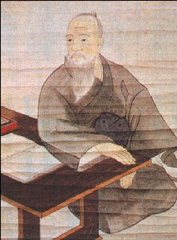Sai On facts for kids
Quick facts for kids
Sai On
|
|
|---|---|
|
蔡 温
|
|
 |
|
| Sanshikan of Ryukyu | |
| In office 1728–1752 |
|
| Preceded by | Nago Ryōi |
| Succeeded by | Kochinda Chōei |
| Kokushi of Ryukyu | |
| In office 1712–1762 |
|
| Personal details | |
| Born | October 25, 1682 Kamemura, Naha, Ryūkyū Kingdom |
| Died | January 23, 1762 (aged 79) |
| Parents | Sai Taku (father) Magozei (真呉瑞, mother) |
| Childhood name | Kamado (蒲戸) |
| Japanese name | Gushichan Bunjaku (具志頭 文若) |
| Rank | Ueekata |
Sai On (1682–1761) was a very important official in the Ryukyu Kingdom. This kingdom was a powerful island nation that existed for many centuries. Sai On was a scholar-bureaucrat, which means he was a smart person who studied a lot and then worked for the government.
He served as a key advisor to King Shō Kei. Sai On is famous for making many big changes and improvements in the kingdom. He is one of the most well-known people in Okinawan history. He also helped edit an important history book called Chūzan Seifu.
Contents
Early Life and Education
Sai On was born in a village called Kumemura. This village was part of the big port city of Naha. Kumemura was the main place for learning Chinese culture and ideas in Okinawa. Most of the smart government workers came from this village.
Sai On's father was also a scholar and government official. He had studied Confucianism, which is a system of beliefs and values from China. His father even went on several trips to China to give gifts and show respect to the Chinese emperor.
Sai On's father wrote a history book called Chūzan Seifu. He rewrote an older book called Chūzan Seikan. The new book was written in Classical Chinese. Sai On later helped to edit this book in 1724. Many people believe he did this to show a stronger connection to China.
Becoming a Royal Advisor
When Sai On was 27 years old, he traveled to Guangzhou, a city in China. There, he studied many subjects. He learned about how money works (economics), how land is shaped (geography), and how to run a government (political administration). He also studied traditional Chinese books.
After he came back from China, Sai On became a teacher to the Crown Prince. When the prince became King Shō Kei in 1713, Sai On's power and position grew. He even led a special trip to China in 1716 to officially announce the new king.
In 1728, Sai On became a member of the Sanshikan. This was a group of three main advisors to the king. Even though Sai On was not from the royal family, he was given a lot of power. He helped make many important changes to the government.
Big Changes for the Kingdom
Under Sai On's leadership, many land reforms were started. These included:
- Turning unused land into farms.
- Moving and setting up new towns.
- Building systems to bring water to farms (irrigation).
- Controlling floods.
- Planting many trees.
Sai On also made rules about where farmers could live and what kind of work they could do. Farmers were not allowed to move to cities easily. They also had limits on how much craft work, like woodworking, they could do. This helped make farming better and more efficient. It also made sure that skilled workers stayed in the cities of Naha and Shuri.
Because of Sai On's changes, the kingdom started producing more goods and food than ever before.
Supporting the Aristocrats and Artisans
Starting in 1723, the anji, who were the traditional lords of different areas, began to receive money from the government. This money came in the form of rice. This change helped connect them more closely to the central government. It also helped them financially, so they didn't have to rely only on what they inherited.
Sai On also encouraged rich people (aristocrats) to become skilled craftspeople. They could do this without losing their high social rank. In 1734, taxes for craftspeople in the cities were removed. This helped more people become artisans and increased the production of handmade goods. The government also started giving special awards to excellent craftspeople, artists, and performers.

Protecting Forests
Okinawa used a lot of wood, more than its forests could naturally grow back. This, along with heavy rains and strong storms (like typhoons), caused a lot of soil to wash away and led to landslides. Sai On is especially famous for his efforts to protect the forests and soil.
Even today, some trees and forest areas are called "Sai On pines." His writings about forestry and saving nature were so important that they were translated and shared even after World War II. Sai On also wrote other important documents. One was a guide for government officials in different areas. Another was called "Travelers' Advice," which helped Okinawans traveling in China hide the close relationship between Okinawa and Japan's Satsuma Domain.
Later Life
In 1734, a group of government officials, led by Heshikiya Chōbin, disagreed with Sai On. They thought he was too supportive of China. However, before they could act against Sai On, Chōbin and others were arrested.
Sai On retired from his important government job in 1752. This was the year after King Shō Kei passed away. Sai On remained an important and respected figure until his own death in 1761, at the age of 79.
See also
 In Spanish: Sai On para niños
In Spanish: Sai On para niños

